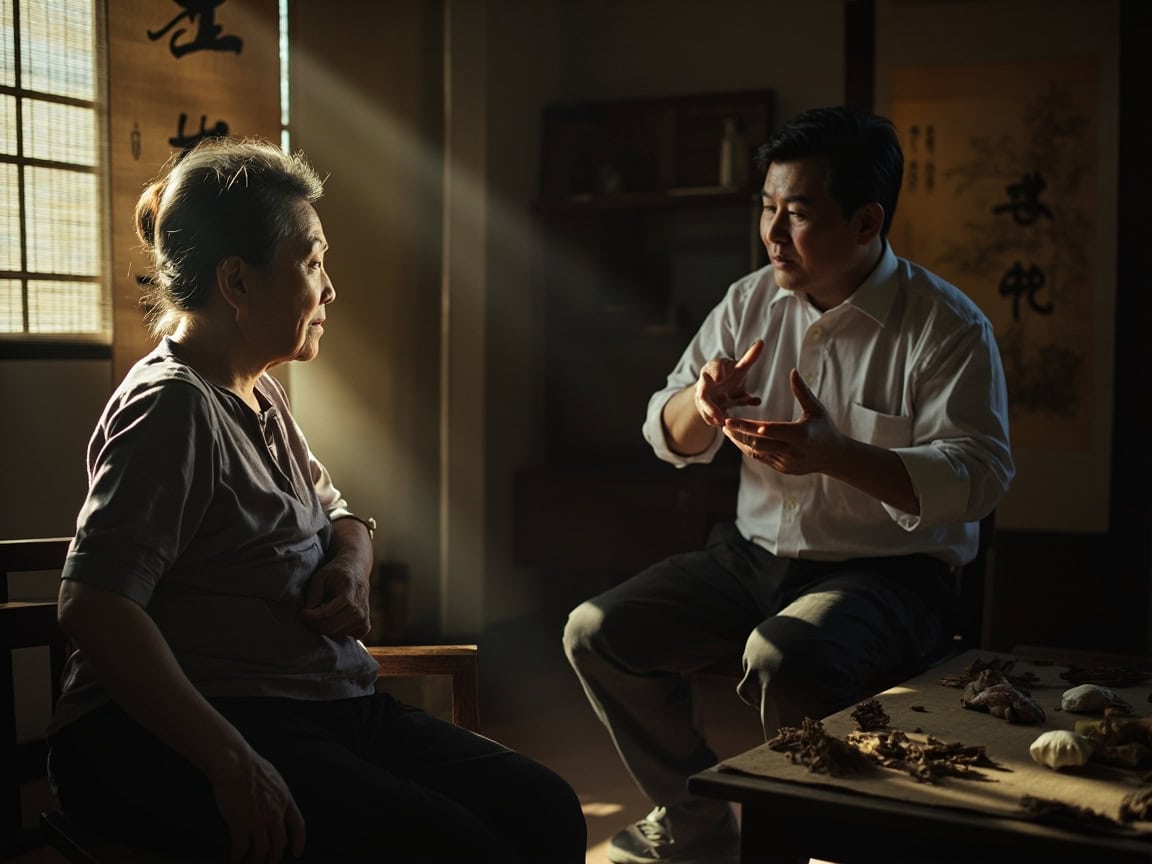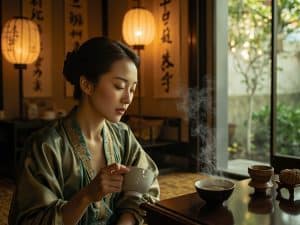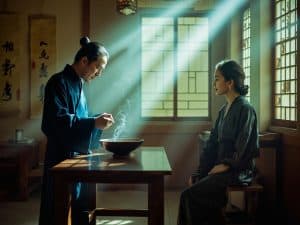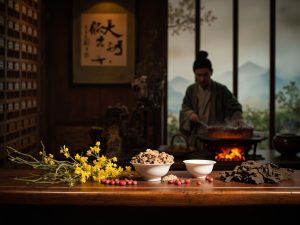Table of Contents
ToggleTraditional Chinese Medicine Case Analysis 10: Cerebral Infarction, Weakness and Numbness of the Left Limb
Author: Gu Yuxi Editor: Gu Yuxi Translator: Gu Yuxi
The Traditional Chinese Medicine medical case comes from Teacher Lin’s public WeChat account 《中医林佳明》’s 【Classic Case Teaching Episode 9】.
The original text is as follows:
First Visit
Female, 66 years old, has had cerebral infarction for over a month. After acute phase treatment in a local hospital, she is currently taking antiplatelet and plaque-stabilizing medication. She came for consultation after receiving other treatments.
Symptoms presented:
Weakness and numbness of the left limb, bowel movement once every 3 days, dry and bitter mouth, irritability, poor appetite, medium build, muscle strength of the upper and lower limbs grade 3, dark red tongue tip, yellow tongue coating, dark lips, obvious varicosity under the tongue, wiry and thin pulse, deep and thin pulse.
Traditional Chinese Medicine Diagnosis:
Combined Shao Yang and Yang Ming disease, with blood stasis, turbid Yin occupying the Yang position. The treatment principle is to first clear the bowels and resolve blood stasis, allowing a way out for the pathogenic factors.
1.Chai Hu (Bupleurum) 20g, Huang Qin (Scutellaria) 15g, Bai Shao (White Peony Root) 20g, Ban Xia (Pinellia) 10g, Zhi Shi (Immature Bitter Orange) 15g, Sheng Jiang (Fresh Ginger) 10g, Da Zao (Jujube) 10g, Dan Pi (Moutan Cortex) 10g, Fu Ling (Poria) 15g, Tao Ren (Peach Kernel) 10g, 7 doses, one dose daily, decocted in water.
2.Da Huang (Rhubarb) 10g, Rou Gui (Cinnamon Bark) 5g, taken with three cups of hot water daily, as an infusion, to maintain smooth bowel movements, 4-6 times daily. If there is obvious loose stool or watery stool, reduce the frequency of the infusion. Bleeding at Baihui (GV20) and Shixuan (EX-UE11) points.
Second Visit: 2021.05.10
After taking the medicine, the patient had bowel movements four times a day, dry and bitter mouth reduced, weakness, limb numbness, and appetite improved. Pale red tongue, white coating, deep, thin, and weak pulse.
Traditional Chinese Medicine Diagnosis:
Tai Yin disease, deficiency of Yang Qi, deficiency of Qi and Blood, unable to nourish the meridians.
Steamed Fu Pian (Processed Aconite) 30g, Gan Jiang (Dried Ginger) 30g, Zhi Gan Cao (Honey-fried Licorice Root) 45g, Huang Qi (Astragalus) 120g, Gui Zhi (Cinnamon Twig) 45g, Bai Shao (White Peony Root) 45g, Sheng Jiang (Fresh Ginger) 60g, Da Zao (Jujube) 20g, Di Bie Wan (Earthworm-Leech Pill), Zhi Jing San (Antispasmodic Powder), Dang Gui (Chinese Angelica Root) 30g, Chi Shao (Red Peony Root) 30g, Ze Xie (Alisma) 24g, 7 doses, one dose daily, decocted in water.
After taking the medicine, the patient’s muscle strength did not change. It was recommended to continue taking it, gradually increasing the dosage of Fu Zi (Aconite), and adjusting the prescription according to the symptoms. Because the patient had a cold and cough once in between, Chai Hu Gui Zhi Tang (Bupleurum and Cinnamon Twig Decoction) was used, and then the previous prescription was continued, with the dosage of Fu Zi reaching 90g.
After two months of treatment, the patient’s muscle strength recovered to grade 4+, upper limb grade 4, and she was basically able to take care of herself. The patient and her family were particularly grateful. The patient has currently stopped medication and has not experienced another cerebral infarction.
Questions for Reflection from Lin Jiaming:
1.How does the process of this case transitioning from Shao Yang and Yang Ming to Tai Yin reflect the similarities and differences between the transmission patterns of “Shang Han Lun (Treatise on Cold Damage)” and the transformation rules of “miscellaneous internal diseases”? How to grasp this dynamic change in the treatment of chronic diseases?
2.In the initial diagnosis, with bowel movements aimed at 4-6 times a day, if manifestations such as “uncontrolled purging, rapid and forceful pulse” appear, how should the purgative strength be adjusted? What are the judgment criteria?
3.The modern pharmacopoeia stipulates that the common dosage of Fu Zi (Aconite) is 3-15g. In this case, 90g was used safely and effectively. From the perspective of “no harm when there is a reason,” how to understand the correspondence between dosage and the pathogenesis?
4.The principles of using and adjusting insect-based drugs: Di Bie Wan (containing earthworm and leech) and Zhi Jing San (containing scorpion and centipede) were used in the Tai Yin disease stage. How to avoid “attacking and damaging the body’s Qi”? What is the profound meaning of their combination with Qi-tonifying drugs?
5.The synergistic mechanism of combining classic formulas: The combination of Da Chai Hu Tang (Major Bupleurum Decoction) and Gui Zhi Fu Ling Wan (Cinnamon Twig and Poria Pill), in addition to resolving stagnation, clearing the bowels, and promoting blood circulation to remove blood stasis, what synergistic effects did it produce in regulating the metabolism of “Qi, Blood, and Fluids”?
My Answers:
1.Answer to Question 1:
Similarities and Differences in Transmission Patterns:
From the perspective of Shang Han Lun, the transition from combined Shao Yang and Yang Ming disease at the first visit to Tai Yin disease at the second visit aligns with the transmission pattern of “pathogenic factors entering from the exterior to the interior” and the sequence of “Yang meridians → Yin meridians” in Shang Han Lun.
However, this patient’s condition is a miscellaneous internal disease. The “deep and thin pulse” at the initial visit suggests an underlying Yang deficiency. While clearing the bowels and resolving blood stasis during treatment alleviated the Yang Ming heat accumulation, it accelerated the manifestation of Tai Yin deficiency and cold (deep, thin, and weak pulse, white tongue coating at the second visit). This is a typical manifestation of “deterioration due to treatment” in internal miscellaneous diseases, which differs from the unidirectional deepening of pathogenic factors in simple cold damage.
The coexistence of Qi and blood stasis (varicosity under the tongue) and Yang Qi deficiency (weakness of the limbs) after cerebral infarction aligns with the theory of “opening, closing, and pivoting” in the Nei Jing (Inner Canon of Medicine), specifically the dual pathogenesis of Tai Yin (Spleen) failing to transport and transform, and Shao Yin (Kidney) failing to warm. It is necessary to consider the interaction between phlegm/blood stasis and Yang deficiency.
How to Grasp Dynamic Changes:
In the treatment of chronic diseases, there is usually a combination of deficiency and excess. It is important to determine whether the patient’s overall condition leans towards Yang or Yin. In this case, there was both Shao Yang disease and Yang Ming disease with constipation. The priority was to harmonize Shao Yang and relieve constipation. After these issues were addressed, the remaining condition was mainly Yin-predominant, requiring timely warming and tonifying to prevent the progression of Tai Yin disease.
For safety, Rou Gui (Cinnamon Bark) was used for mild warming and tonifying during the first visit, but the overall medication focused on expelling the pathogenic factors to allow them an exit. In the second visit, the treatment was not entirely warming and tonifying; there were also blood-activating and stasis-resolving herbs. However, the overall focus of the medication was definitely on warming and tonifying.
2.Answer to Question 2:
| Degree of Excess|Has 7-8 loose bowel movements daily, pulse is thready but felt with strength upon deeper palpation.|Reduce rhubarb and immature bitter orange by half, add 30g stir-fried yam and 15g Poria to strengthen the spleen and promote dampness elimination.|
|Moderately excessive|Has more than 8 watery bowel movements daily, pulse is rapid and urgent.|Stop purgative medications, heavily use astringents and warming yang to prevent prolapse.|
|Severely excessive” or “severe excess.|”Uncontrolled purging accompanied by clouded consciousness, pulse faint and on the verge of disappearing.|At this point, it’s a Jueyin disease. You need to find a way to revive the yang and rescue from collapse.|
3.Answer to Question 3:
The Nei Jing proposes “no harm when there is a reason,” indicating that when the body has a severe pathological basis, even the use of toxic drugs (such as Fu Zi) will not cause serious damage. In this case, the patient was in a state of Tai Yin disease with Yang Qi deficiency (deep, thin, and weak pulse, pale tongue with white coating, grade 3 muscle strength in the limbs). The pathological essence was Yang failing to control Yin and the blockage of turbid stasis. At this time, the warming and cold-dispersing effect of a large dose of Fu Zi (90g) highly matched the pathogenesis.
After cerebral infarction, the patient had blood and Qi stagnation (obvious varicosity under the tongue) + Yang Qi decline (weakness of the limbs, deep and thin pulse), belonging to a critical state of “extreme Yin cold, imminent Yang collapse.”
The conventional dosage of 3-15g is only suitable for mild Yang deficiency, while this case required breaking through the “rescuing Yang and reversing collapse” threshold (≥30g). Studies have shown that the effective dose of Fu Zi in treating heart failure is mostly between 30-200g.
4.Answer to Question 4:
Two Major Strategies to Avoid Attacking and Damaging the Righteous Qi:
- Gradual Dosage Control: Start with low doses of Di Bie Wan and Zhi Jing San, and dynamically adjust (increase or decrease) based on patient feedback.
- Combination with Qi-tonifying Herbs: For example, Gui Zhi and Huang Qi.
The Deeper Connection Between Qi-tonifying and Pathogen-expelling Herbs:
- When Qi moves, blood circulates.
- When Yang is unblocked, the collaterals are naturally clear.
- When the Earth (Spleen) is robust, insects are subdued.
Dynamic Balance Model – Zhu Liangchun’s Experience: When Qi-tonifying herbs are combined with insect-based drugs in a 3:1 ratio, the rate of muscle strength recovery is 1.8 times that of using insect-based drugs alone.
5.Answer to Question 5:
I. Dynamic Balance of Qi Mechanism Ascending and Descending:
1.Unblocking and Purgative Effects of Da Chai Hu Tang:
- Soothes Shao Yang and descends Yang Ming: The combination of Chai Hu and Huang Qin soothes Shao Yang stagnation and heat, while Zhi Shi and Da Huang unblock and descend Yang Ming fullness, synergistically restoring the “opening and closing of the pivot” function, allowing orderly ascending and descending of Qi.
- Regulates both Liver and Spleen: Chai Hu soothes the Liver and promotes Qi circulation, Bai Shao softens the Liver and alleviates spasms, Ban Xia and Sheng Jiang harmonize the Stomach and descend counterflow, forming a Qi circulation chain of “soothing the Liver → strengthening the Spleen → unblocking and descending.”
2.Qi Transformation Promotion of Gui Zhi Fu Ling Wan:
- Gui Zhi warms and unblocks Yang Qi: promoting the circulation of Qi and Blood.
- Fu Ling strengthens the Spleen and promotes diuresis: forming a “Qi movement promotes fluid movement” effect with Chai Hu‘s dredging of the Triple Burner.
II. Bidirectional Regulation of Blood Stasis and Heat:
1. Blood-activating and Mass-resolving Effects of Da Chai Hu Tang:
- Da Huang and Tao Ren synergistically break down blood stasis: forming a “breaking stasis → expelling toxins” pathway.
- Dan Pi and Chi Shao cool the blood and resolve blood stasis: interrupting the vicious cycle of “stasis and heat mutually binding → damage to body fluids.”
2. Stasis-transforming and New-generating Effects of Gui Zhi Fu Ling Wan:
- Gui Zhi and Shao Yao harmonize the Ying and Wei levels.
- Tao Ren and Fu Ling regulate bidirectionally.
III. Three-Dimensional Regulation of Fluid Metabolism:
1. Dredging the Waterways of the Triple Burner:
- Upper Jiao: Chai Hu and Gui Zhi disseminate Lung Qi (“lifting the lid of the kettle”).
- Middle Jiao: Zhi Shi and Fu Ling strengthen the Spleen and drain dampness.
- Lower Jiao: Da Huang and Mu Dan Pi unblock the two lower orifices, Gui Zhi and Tao Ren warm and transform cold-dampness.
2. Interrupting the Interlocking of Phlegm, Stasis, and Fluids:
- Treating phlegm and stasis together: Ban Xia and Fu Ling resolve phlegm, Tao Ren and Dan Pi transform blood stasis.
- Regulating blood and fluids together.
The following is the essence of Teacher Lin Jiaming’s interpretation. Those interested can directly read the original text – Teacher Lin Jiaming’s Classic Case Teaching Episode 9.
I. Stages of the Case and Key Points of Treatment:
1. Initial Visit Stage (Combined Shao Yang and Yang Ming Disease):
- Main symptoms: Dry and bitter mouth / constipation / dark red tongue with yellow coating
- Treatment: Da Chai Hu Tang + Gui Zhi Fu Ling Wan
- Key adjustment: Da Huang + Rou Gui infusion, control daily bowel movements to 4-6 times.
2. Second Visit Stage (Tai Yin Disease):
- Main symptoms: Pale tongue with white coating / deep, thin, and weak pulse / fatigue
- Treatment: Modification of Si Ni Tang (Four Cold Extremities Decoction) + Huang Qi Jian Zhong Tang (Astragalus and Maltose Decoction)
- Dosage characteristics: Fu Zi increased to 90g, Huang Qi used at 120g.
II. Essential Efficacy of Herbs:
- Chai Hu: Soothes stagnation of Qi mechanism.
- Da Huang: Dual effect of purging and blood activation.
- Fu Zi: Breaks through Yin cold and invigorates function.
- Huang Qi: Tonifies Qi, supports the exterior, and promotes tissue repair.
- Gui Zhi: Warms and unblocks blood vessels throughout the body.
- Tao Ren: Specifically targets blood stasis in the collaterals.
III. Core Treatment Thinking:
1. Dynamic Differentiation:
Transmission from Shao Yang/Yang Ming (Excess pattern) → Tai Yin (Deficiency pattern). Change in tongue coating from yellow → white is a sign of pathological transformation.
2. Tonifying and Purging Strategies:
- Early stage: Purging and detoxification (Da Huang, Rou Gui).
- Later stage: Warming Yang and tonifying Qi (Fu Zi, Huang Qi).
3. Dosage Principles:
Fu Zi 30-90g gradually increased to dispel cold. Huang Qi 120g to tonify Qi and support.
IV. Clinical Summary:
1. Treatment Logic Chain: Purging heat and detoxification (urgent) → resolving stasis and unblocking collaterals (intermediate) → warming and tonifying the root (gradual).
2. Key Node Control: Bowel movement frequency as an indicator for Da Huang adjustment. Changes in tongue appearance indicate the timing for switching between purging and tonifying.
3. Embodiment of Holistic View: Insect-based drugs (dredging), bloodletting (releasing heat), and decoctions (regulating) form a three-dimensional treatment network.
Lin Jiaming said that in terms of stroke, some ideas are similar to the treatment of trigeminal neuralgia, which was summarized in this article before –Summary of TCM Treatment Techniques and Approaches for Trigeminal Neuralgia
Regarding the issues of cerebral infarction, Xue Xiaozui also summarized several key points:
1.The timing of intervention: generally, the best effect is when TCM intervention follows Western medicine treatment, and the effect gradually decreases afterward.
2.Early stage requires promoting blood circulation and unblocking the bowels.
3.It is necessary to ensure the body’s vital Qi .
4.Here, insect-based drugs are basically necessary, with leech being the main one..
Grasping these points and strictly implementing them does have curative effects, though it’s unclear how long they can be maintained.
If it’s not hemiplegia but dizziness and headache, I know that increased original dosage of kidney-tonifying herbs plus leech can be used.
Cerebral infarction has these symptoms: hemiplegia, dizziness and headache, constipation.
The above are Xue Xiaozui’s original words. Thank you to Xue Xiaozui for the guidance, and to Lin Jiaming for the sharing and explanation.
Disclaimer:
The experiences and insights shared above represent the author’s personal usage and understanding, and are provided for reference only as part of academic exchange. Please do not blindly replicate or apply them; any consequences arising from such actions are solely your responsibility. As individual constitutions vary, medication should be tailored accordingly. It is advisable to use such treatments under the guidance of a qualified physician. If you have additional experiences to share, comments and submissions are welcome.
If you appreciate my article, please give it a like.
If you are a generous and affluent individual, please consider making a donation!
Your recognition is my greatest motivation to continue writing—thank you very much!
USD Donation Button —
A RMB donation button is available below.
 微信赞赏
微信赞赏 支付宝赞赏
支付宝赞赏




